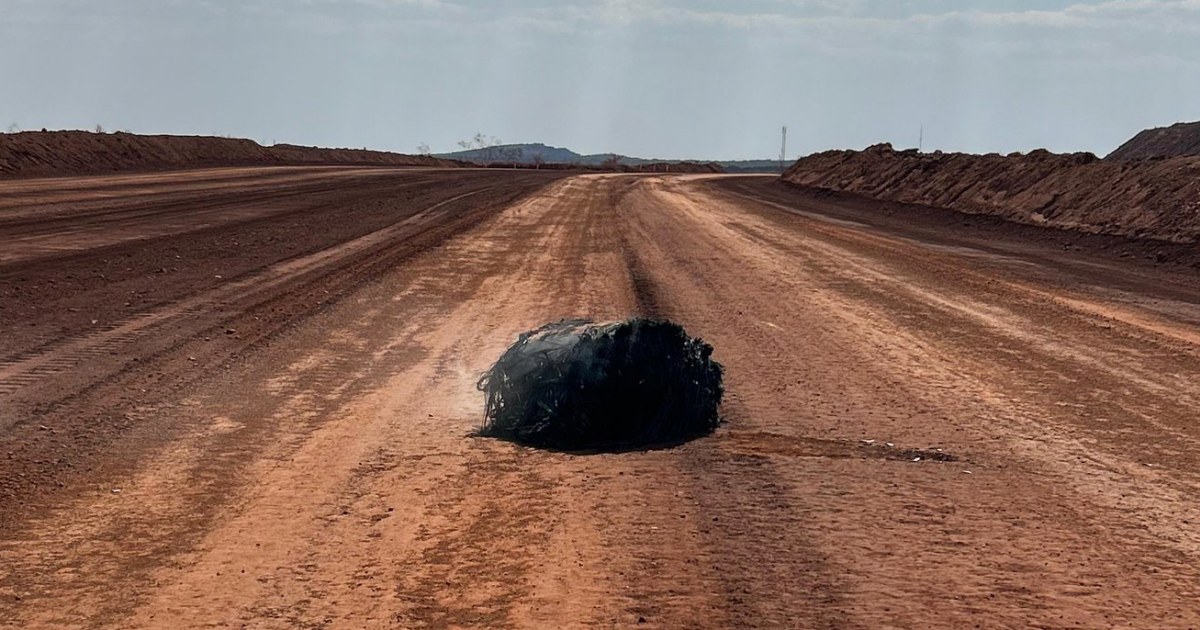World
Large Chunk of Suspected Space Debris Discovered in Australia

A significant discovery was made in the Pilbara region of Western Australia, where a large piece of suspected space debris was found in a remote desert area. The Australian Space Agency confirmed the find on Monday, stating that the charred object was located following reports from local mine workers. Initial assessments suggest that the object is likely a spent rocket component.
The Australian Space Agency reported via social media that “the debris is likely a propellant tank or pressure vessel from a space launch vehicle.” While the agency has not disclosed specific details regarding the object’s size and weight, it is actively collaborating with local authorities and international space agencies to determine both its nature and origin. An inquiry is underway to gather further information about this unusual find.
Local officials indicated that they do not believe the debris poses any immediate threat to public safety. According to a report from Sky News, the discovery was made on Saturday along a remote access road, and no injuries or hazards have been reported. However, NBC News has not independently verified these details.
The presence of space debris is a growing concern, particularly as the frequency of launches into orbit increases. Government space agencies and private companies often allow spent rocket parts and defunct satellites to burn up upon re-entry into the atmosphere. Nevertheless, fragments can occasionally survive this process and land on Earth.
While it is uncommon for space debris to fall over land, it is even rarer for it to land in populated areas. This incident follows a series of notable events involving space debris. For example, last summer, a 90-pound piece of debris was found on a mountain trail in North Carolina; it was later identified as part of a service module from a SpaceX Crew Dragon capsule. In March 2024, a 1.6-pound metal fragment crashed through a home in Naples, Florida, traced back to a cargo pallet released from the International Space Station.
Experts have raised alarms about the increasing accumulation of space debris, emphasizing the potential risks it poses to operational satellites and the safety of astronauts aboard the International Space Station. Tens of thousands of pieces of space junk, along with millions of smaller fragments, orbit the Earth at speeds reaching up to 18,000 miles per hour. The danger these objects present underscores the need for effective debris mitigation strategies.
In light of these challenges, organizations such as NASA and the Australian Space Agency are investing in research and technology aimed at tackling space junk. The Australian Space Agency reiterated its commitment to the long-term sustainability of outer space activities and continues to advocate for debris mitigation on an international platform.
As the investigation into the recent discovery unfolds, the implications for space safety and environmental considerations remain at the forefront of discussions in the global space community.
-

 Business4 days ago
Business4 days agoInvestors Eye Potential $60,000 Gains with Ozak AI Token
-

 Politics5 days ago
Politics5 days agoFormer Pastor Arrested on Human Trafficking and Indecent Charges
-

 Business5 days ago
Business5 days agoQuotient Wealth Partners Adjusts Holdings in iShares Russell 1000 ETF
-

 Lifestyle5 days ago
Lifestyle5 days agoNatty from KISS OF LIFE Stuns in Micro-Shorts at Seoul Event
-

 Politics4 days ago
Politics4 days agoSkip Bayless Critiques Travis Hunter’s Game Day Baptism
-

 Entertainment5 days ago
Entertainment5 days agoUtah Residents Face Resource Shortages Amid Ongoing Government Shutdown
-

 Business5 days ago
Business5 days agoCalifornia to Ban All Plastic Bags in Grocery Stores by 2026
-

 Entertainment5 days ago
Entertainment5 days agoPete Davidson Surprises Pregnant Girlfriend with Private Jet to Concert
-

 Entertainment5 days ago
Entertainment5 days agoAce Frehley, KISS Guitarist, Passes Away at 74 After Fall
-

 Science5 days ago
Science5 days agoCommunity Mourns Loss of Judith Ernst, Pioneer Educator at 81
-

 Politics5 days ago
Politics5 days agoIberia Parish Sees Surge in Marriage Licenses Issued in October
-

 Science5 days ago
Science5 days agoMIT Develops Groundbreaking 3D Brain Models for Personalized Therapies









